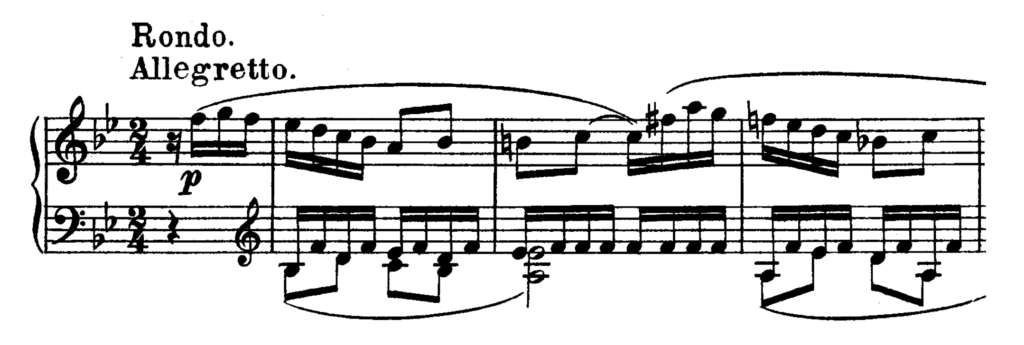Analysis
Contents
For the benefit of all pianists learning this work, we present to you a concise and easy to use analysis of Beethoven’s Piano Sonata No.11 in Bb major.
First Movement (Allegro Con Brio)
Form: Sonata Form. Bb Major.
EXPOSITION:
Bars 1-12: First Subject in B flat major (tonic). The first phrase of the first subject only consists of 3.25 bars, and the rhythm of it seems incomplete. Three silent beats at the beginning would make the phrase four pars, and therefore well defined; or the first three peats of Bar 5 may be considered as belonging to the first phrase as well as the second phrase, the end of the former overlapping the latter. The first subject ends on the dominant. The first subject may possibly end at Bar 9.
Bars 12-22: Connecting Episode. The connecting episode begins (with a figure borrowed from Bars 3-4) in the tonic key, soon after followed by two bars in sequence, leading to six bars on pedal point (key of C major).
Bars 23-57: Second Subject in F major. The first bar of the second subject is accompanied by the passage which links the connecting episode of it, transposed a fifth lower. The subject is divided into three portions – first portion, Bars 23-31; second portion, Bars 31-44; third portion, Bars 45-57. The third portion begins very abruptly at Bar 45, and robs the second portion of the completion of its last phrase.
Bars 57-69: Coda. The beginning of the Coda is taken from the second portion of the second subject, upon pedal point.
Double bar and repeat.
DEVELOPMENT:
Bars 70-129: The development is principally formed upon the Coda and the figure at the commencement of the first subject’ it closes upojn the dominant seventh.
RECAPITULATION:
Bars 129-140: First Subject in original key.
Bars 140-154: Connecting Episode. The connecting episode is altered so as to end in the dominant key, instead of the key of C, as before.
Bars 155-189: Second Subject in B flat major (tonic).
Bars 189-End: Coda. The original Coda is almost literally transposed into tonic key.
Second Movement (Adagio Con Molto Espressione)
Form: Sonata Form. Eb Major.
EXPOSITION:
Bars 1-12: First Subject in E flat major (tonic).
Bars 13-19: Connecting Episode. The connecting episode is not constructed upon previous material, but is in the form of an episode beginning in the tonic key and modulating to the dominant.
Bars 19-28: Second Subject in B flat major.
Bars 28-31: Coda.
DEVELOPMENT:
Bars 32-38: The second subject is not referred to in the development, it being confined to the first subject.
RECAPITULATION:
Bars 48-58: First Subject (varied) in original key. The last two bars of the first subject are omitted.
Bars 58-66: Connecting Episode. The connecting episode is altered to end in tonic key.
Bars 66-75: Second Subject in E flat major (tonic).
Bars 75-End: Coda.
Third Movement (Menuetto)
Form: Ternary Form. Bb Major.
FIRST PART:
The Menuetto is in Simple Binary form.
Bars 1-9: First Subject commencing in B flat major (tonic).
Double bar and repeat.
Bars 10-18: Episode.
Bars 18-26: First Subject (varied) in original key.
Bars 26-32: Coda.
Double bar and repeat from Bar 10.
SECOND PART:
The Minore (Trio) is in Simple Binary form.
Bars 1-9: First Subject in G minor, ending in D minor.
Double bar and repeat.
Bars 10-14: Development.
Bars 14-18: First Subject (shortened) in original key, altered so as to end in G minor.
Double bar and repeat from Bar 10.
THIRD PART.
Menuetto Da Capo.
Fourth Movement (Rondo: Allegretto)
Form: Rondo Form. Bb Major.
FIRST PART:
Bars 1-19: First Subject in B flat major (tonic). The first subject commences with a section of eight bars, ending in the dominant key, which is repeated (varied), ending in tonic key, Bar 17, two more bars being added, ending with full close in tonic key.
Bars 19-23: Episode. This modulating episode consists of a new figure in tonic key, modulating to the dominant key.
Bars 23-41: Second Subject in F major. The last eight bars of the second subject consists entirely of arpeggio chords in the right hand in demisemiquavers (thirty-second notes), and the same in the left hand in quavers (eighth notes), the first five bars of which are built upopn tonic pedal point (of F major).
Bars 41-50: Bars 41-50 constitute a passage of imitation formed on figure of first subject, leading back to tonic key.
Bars 50-68: First Subject in original key.
SECOND PART:
Bars 68-112: The second part begins with the figure of the episode, which forms an important part in this development, Bars 81-95. A new subject is introduced, Bars 73-81, repeated in B flat minor, Bars 96-194. Bars 104-112 form a passage leading back to the tonic key.
THIRD PART:
Bars 113-130: First Subject (varied) in original key.
Bars 130-136: Episode. This episode is constructed upon the same material as the original one, altered so as to end in tonic key, instead of the dominant.
Bars 136-153: Second Subject in B flat major (tonic) The concluding part of the second subject is altered; instead of ending in the key in which it begins, as it originally did, it modulates to the key of E flat, and leads into a transient return of the first subject.
Bars 153-165: Bars 153-165 form a passage founded upon first subject leading to the final entry of that subject.
Bars 165-183: First Subject (varied) in original key.
Bars 183-End: Coda. At the commencement of the Coda a new figure is introduced, it ends with a reference to the first subject.










